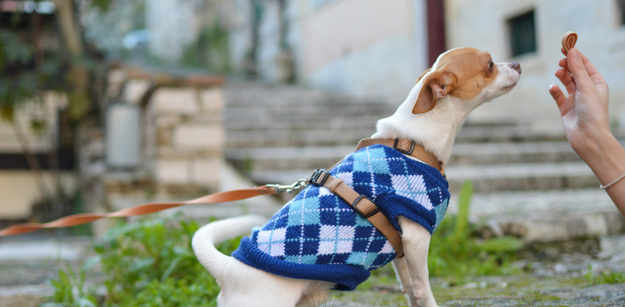Do you wish to walk your dog, but cannot tell whether to keep her on a harness or collar? While each of these tools has unique uses, it is advisable to walk your dog on a harness instead of a collar.
But why do you need to walk your dog on a harness?
Consider the following six benefits of walking your dog on a harness instead of a collar.

1. A Harness Minimizes Pressure Exerted on Your Dog’s Neck
Wondering how? Well, a harness is designed to discourage excessive and forceful pulling. As a result, your dog experiences minimal chances of trauma.
When your dog pulls against her collar vigorously, her neck is subjected to enormous pressure. In turn, your pup could develop breathing complications and dog anxiety. The anxiety may make your canine to pull more which results in a pulling-anxiety vicious cycle.
Especially, a harness is appropriate for brachycephalic dog breeds which are more vulnerable to respiratory health problems.
Walk your pup on a harness to avoid potential long-term physical damage to your dog’s spine and neck caused by a collar.
2. A Harness Allows Better Canine Control
Do you wish to control your dog during your walk? You will enjoy the walk more when you are in control of your dog, even if she is big and robust. As expert views suggest, a harness gives you a higher control level when you are walking your dog (1).
If you are inexperienced in walking dogs, a harness is an absolute necessity.
I find it annoying how a collar allows a dog some freedom to resist my control. My dog has once managed to wiggle her way out of her collar and wandered off. Use a harness to avoid such inconvenience.
You will love that the design of a harness forces the dog to face the direction you take. Since a dog harness comes with multiple contact points, the harness offers your canine more security and makes you more confident.
With the best dog harness, even your dog is well-built and energetic is controlled with ease as compared to a collar.
3. A Harness Offers Better Support for Injured Canines
Is your dog either handicapped or injured? Then you need a harness to walk her.
As research reveals, a harness offers greater physical support for your dog when climbing stairs or taking a walk outside.
As the dog owner, take advantage of the multiple contact points to help your dog to recover faster through exercise such as walking outdoors.
The best dog harness should allow you to lift your injured or handicapped dog if she is unable to go over obstacles as you walk. The harness also enables you to lift your dog simultaneously. However, lifting your dog from either the back or front is quite comfy for your canine.
4. A Harness Improves Owner-dog Communication
Do you wish to train your dog a few commands as you take her for a walk? If you do, then consider getting the best dog harness for your canine.
A harness can help you to achieve better communication with your dog. Remember, a typical harness has a minimum of two connection points. This design enables you to influence and promote the desired behavior easily. With a harness, you can communicate desired training commands with ease and convenience (2).
For instance, if you gently lift the dog on the back point of connection of your harness, you will be communicating to the canine that she should slow down. Alternatively, you can rely on the connection at the front to teach a command for direction.
The harness enhances such communication without affecting your dog’s breathing, nor does it promote painful pulling. Therefore, the harness makes dog training more enjoyable during walks.
5. A Harness Discourages Tangling
Yes, your dog can tangle if she is on a collar. How? Your dog could be excited, twisting, jumping, or fighting her retractable dog leash. The dog could even possibly tangle you in the leash as well.
If your dog is strong and big enough, she could potentially wrap the retractable dog leash (look at it in the detailed article here.) around your wrist, arms, fingers, or legs. This could result in either a painful pinch or bruise.
Your dog lacks the knowledge of her strength, and could not be understanding the possible danger of tangling. However, with a retractable dog leash that is attached to your dog’s harness on the back minimizes chances of tangling and possible injury.
6. A Harness Is Safe and Comfortable for All Dog Sizes
Which size is your canine? Is she huge or small? Well, with the harness, you are not worried about the size of your dog.
Notably, dogs that are muscular and huge are typically very strong. While this is not good, such a dog can be unruly. Notably, a muscular dog who lacks proper training in good retractable dog leash behavior could have pulling tendencies. The harness will be appropriate for such a dog as it discourages pulling.
Alternatively, small breeds of dogs are typically more prone to physical injury owing to their delicate nature. Therefore, a harness is essential in spreading pressure from a single small surface of the dog’s neck to the rest of her back and whole body. Dispersing the pressure over an extensive surface area reduces the effect of the pressure on the dog.
However, note that even the best dog harness has its limitations. For instance, the harness should be restricted to use for outdoor walks only. This means that you should take off the harness while at home or as the dog goes to sleep. This minimizes chances of the harness matting or rubbing off your dog’s fur which could irritate your dog’s skin. The harness could also be annoying to your canine.
Do you have more reasons for using a harness over a collar on your dog as you walk her outside?



